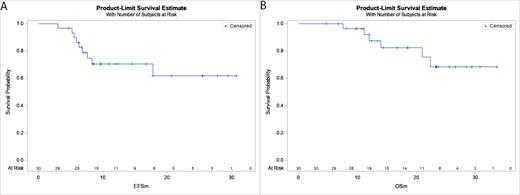Abstract
The advent of pediatric inspired regimens has improved the outcome for younger adults with Acute Lymphoblastic Leukemia (ALL), however this comes at a considerable toxicity burden limiting its applicability in older adults. The advent of novel immunotherapies, such as Blinatumomab, an anti-CD19 targeting Bi-specific T-cell engager, has improved outcomes for adults with relapsed refractory and minimal residual disease (MRD) positive B-precursor (BCP) ALL. The Australasian Leukemia and Lymphoma Group (ALLG) undertook a phase 2 proof-of-concept study to explore the combination of Blinatumomab with reduced intensity chemotherapy in adults with newly diagnosed Ph- BCP ALL.
Patients received an initial pre-phase of corticosteroids (Prednisolone 100mg/d, 5 days) followed by a low intensity chemotherapy debulking (Cyclophosphamide 150mg/m 2 BD D1-3, Vincristine 2mg IV D1, 11 and Dexamethasone 10mg/m 2 D1-4, D11-14). Following this patients received Blinatumomab at 9mcg/d days 1-7 and 28mcg/d days 8-28. A B cycle of Hyper-CVAD (Cytarabine 3g/m 2 BD for 4 doses and Methotrexate 1g/m 2 D1 with Methylprednisolone 50mg BD D1-3). Patients then received 3 alternating cycles of Blinatumomab (28mcg/d for 28 days) and B-cycles of Hyper-CVAD followed by 2-years of POMP maintenance in subjects not proceeding to allogeneic stem cell transplant (alloHSCT) which was at investigator discretion. MRD assessments by ASO-PCR were performed after the first B cycle, second B cycle and prior to maintenance therapy with an MRD response being a level of 10 -4 or less. This analysis is from a pre-specified interim analysis with a data cutoff of 29 th June 2021.
30 patients were enrolled with a median age of 51.7(range, 39.5 - 66.5 years) with 70% male subjects. ECOG performance score was 0 in 14 subjects, 1 in 12 and 2 in 4. High risk disease was identified in 5 subjects (1 t(4;11), 2 hypodiploid, 1 t(1;19) and 1 Ph-like). All patients attained a CR, with 28 at end of 1B and a further 2 at end of 2B. Of 26 patients evaluable for MRD, 70% had achieved an MRD response after cycle 1B and 83% at the end of cycle 2B. 15 patients have ceased study therapy; 6 patients died with progressive disease, 4 subjects exited to allogeneic stem cell transplant, 1 patient was withdrawn due to progressive disease, 1 had intolerable toxicity (peripheral neuropathy) and 1 at investigator discretion. There were no treatment related deaths. 15 remain on protocol in maintenance with the remainder having completed therapy. At data cut-off the median event free survival (EFS) was not reached (95% CI 8.3 months - NA) with an estimated 24 month EFS of 61.8% (95% CI 36.3 - 84.2%) (figure 1A), and similarly the median overall survival (OS) S was not reached (95% CI 21.0 months - NA) with an estimated 24 month OS of 68.6% (95% CI 41.5 - 85.1%)(figure 1B). This predicted EFS was greater than the pre-specified stopping rule of a 24-month EFS of 50%. 2 episodes of cytokine release syndrome (CRS) were recorded (1 grade 2, 1 grade 3) with the major toxicity being infective (53 episodes of sepsis, infection or febrile neutropenia) predominately related to chemotherapy cycles. 7 episodes of neurological toxicity were demonstrated (1 myelopathy and 4 peripheral neuropathy occurring during chemotherapy and 2 encephalopathy occurring during Blinatumomab administration).
Overall, the combination of Blinatumomab with chemotherapy was tolerable and appeared efficacious with a high rate of remission and deep MRD responses observed. Responses appeared durable despite a low rate of alloHSCTin first remission. The major toxicity was infective and occurred in the context of chemotherapy cycles. Future developments from this protocol will emphasise further reduction in cytotoxic chemotherapy through incorporation of further novel agents to minimise this toxicity.
Fleming: Servier: Honoraria; Pfizer: Honoraria, Speakers Bureau; Abbvie: Honoraria, Speakers Bureau; Amgen: Honoraria, Research Funding, Speakers Bureau. Reynolds: Abbvie: Research Funding; Novartis AG: Current equity holder in publicly-traded company; Alcon: Current equity holder in publicly-traded company. Bajel: Abbvie, Amgen, Novartis, Pfizer: Honoraria; Amgen: Speakers Bureau. Yeung: BMS: Honoraria, Research Funding; Pfizer: Honoraria; Amgen: Honoraria; Novartis: Honoraria, Research Funding. Verner: Janssen-Cilag Pty Ltd: Research Funding. Wei: Abbvie, Amgen, Astellas, AstraZeneca, Celgene/BMS, Genentech, Janssen, MacroGenics, Novartis, Pfizer, and Servier: Honoraria; Novartis, Abbvie, Celgene/BMS: Speakers Bureau; Servier: Consultancy; Abbvie, Amgen, AstraZeneca, Celgene/BMS, Novartis, Servier and F. Hoffmann-La Roche: Research Funding; Abbvie, Amgen, Astellas, AstraZeneca, Celgene/BMS, Genentech, Janssen, MacroGenics, Novartis, Pfizer, and Servier: Membership on an entity's Board of Directors or advisory committees; Former employee of Walter and Eliza Hall Institute: Patents & Royalties: Prof. Andrew Wei is a former employee of the Walter and Eliza Hall Institute and is eligible for a fraction of the royalty stream related to Venetoclax. Greenwood: Jazz Pharmaceuticals: Membership on an entity's Board of Directors or advisory committees; Servier: Membership on an entity's Board of Directors or advisory committees, Research Funding; Pfizer: Membership on an entity's Board of Directors or advisory committees; Amgen: Membership on an entity's Board of Directors or advisory committees, Research Funding.
Blinatumomab - usage in front-line therapy for Acute Lymphoblastic Leukaemia


This feature is available to Subscribers Only
Sign In or Create an Account Close Modal